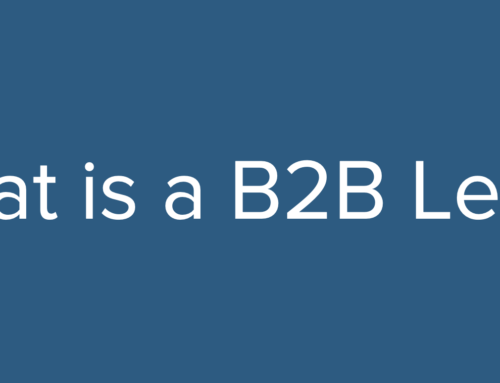B2B Marketing Department Playbook – Chapter 4: Marketing investments you can’t skip (just because you lack resources)
As a one-person or small-staff B2B marketing department, there is likely a tension between executing campaigns/tactics that are visible to the rest of the company and internal marketing investments (which are foundational to delivering the quality and results for those campaigns/tactics). I get it. Your management team wants to measure every dollar you spend. However, an important part of your role is to make sure that a few fundamental, but less-visible, marketing tasks are completed. These are the marketing investments you will need to make behind the scenes to truly be effective in creating the kind of marketing that will deliver visible and measurable success to your company. This is the stuff you can’t skip!
Customer Conversation Mapping
This process has to be a collaboration with key sales team members that have the best understanding of the current market. Having an outside facilitator of this process will keep the group focused and prevent the group “drinking its own Kool-aid.” The goal is to have a conversation map view for each specific customer segment you target. It looks something like this:
For each pain point, there will be corresponding drivers, UVPs, etc., so you can draw a line from each pain point to “map” them across where there are duplicates – thus, it is called a conversation map.
These conversation maps will now provide key insights and usable documentation for creating messaging to engage each customer segment as well as messaging and conversation points useful to your sales team.
- Gather a group together (marketing, sales, customer service, etc.) that have the best insight into what customers are talking about in terms of their pains and decision drives.
- Work your way left to right on the conversation map above and fill in as much as you can. Note – While the messaging themes and concepts might be a bit foreign to the group, you will be surprised at some of the ideas they come up with that will be useful as you move into writing the messaging.
- Document all of this output and use to create questions for prospect/customer interviews. These questions should elicit open-ended answers that further explore and help verify the work your team has done to this point.
- Interview several prospects/customers and perhaps industry experts to get feedback on your initial framework and adjust as needed – with special focus on fine-tuning the pain points and decision drivers.
- Get the internal group back together and review the conversations and possible changes. You are now ready for fine-tuning what I call your “categories of one.”
B2B Marketing Department Playbook: Fine-tuning your “Categories of One”
In all the years I have spent in and around marketing, I believe the hardest thing for any company to accomplish is to accurately and effectively identify their TRUE unique value propositions. Why do I use the phrase “categories of one?” Because unless your company is planning on being a real winner based on volume and/or price, you are going to have to assist the company in identifying what truly makes them unique. In every market segment, you have to move towards a category of one: prospects don’t compare you to anyone else immediately but instead see you as offering something wholly unique.
A great initial test for this is simple. Go to your company home page, cover up the logo, and then ask yourself and others what, if anything, on that page is something that only your company can claim to offer (meaning you could not put a competitor logo up there and it still be true).
You cannot always be a category of one; You may be in a highly competitive market. However, you can work to find what will move you towards a new category of one within that market. If you can’t, well, you better hope your products are a lot cheaper than other products.
- Get your internal group together again (from above).
- Wake them up with the “website test” I mentioned above to stimulate conversation.
- Start going through each assumed unique value proposition and ask hard questions on (a) whether any competitor has this feature/service, (b) how yours compares, (c) how it is unique, (d) how a customer would see this as unique and why/why not?, and (e) where and how your company can been seen as unique?
B2B Marketing Department Playbook: Messaging (value propositions in “buyer” language)
In the conversation map (above), the last column in the map identifies messaging themes or concepts that might work with messaging that ties back to a customer’s pain point. In this “messaging” section, let’s dig into the hard part: writing the messaging.
So many times, when I ask to see a company’s messaging, they show me a potpourri of brochures and content that basically describes how they sell, what they sell, and all the many reasons that the company’s stuff is great. However, it usually fails to resonate with potential buyers that want to know if company has stuff that solves their problems or makes their life easier.
In the end, a prospect is a person, and while a prospect will always evaluate intellectually what you offer, they may or may not connect emotionally to your offering. The role of messaging is to provide key over-arching messages that engage the audience emotionally to learn more. The goal for any “message” is for the person to respond by saying “tell me more about that.”
For example, I could write that GrowthPoint “provides software to help you effectively manage leads,” or I could say that we offer you “easy-to-use tools that empower you and your sales team to accelerate revenue growth.” Both are accurate, but the second taps into verbiage that might stimulate emotions that either relax someone in terms of effort required or excite someone about the possible acceleration of revenue.
When writing or asking someone to write messaging, remember these fundamentals:
- At least a few messages should cover the highest priority pain points and values you identified.
- Messages need to evoke emotion (sounds cheesy but so true).
- Messages need to have internal supporting conversation points (additional wording) and proof points (the actual unique value propositions that support the message) to support your team as they talk with customers.
- Honestly, you should contract with an outside-the industry marketing specialist/writer/consultant-type person or company every single time to lead this process (to get that perspective, reality-check, and freshness required to deliver on messaging).
- Remember to budget for this accordingly. It is a bit expensive because it is a very creative process that requires higher-paid creative thinking (not just anyone can write this stuff).
B2B Marketing Department Playbook: Content Development (content based on messaging to engage buyers)
Once you have developed messaging (and NOT before), you are ready to produce and/or reproduce/refine content to engage your prospects.
You and your product/services group Subject Matter Experts are responsible for producing two kinds of content: (1) sales-enablement content, which provides key information, speeds/feeds, background, messaging, etc. to sales people, and (2) customer-facing content, which should ALWAYS have your defined messages at the center (as the outline or repeated often in the right context.).
Earlier, I mentioned that you will need to invest in content development for each and every segment that you are trying to reach. Why? You cannot ask your customers to do the work of “translating what you believe your values are into their own context (language of market, market needs, etc.). If you are marketing to an automotive audience, they don’t want to read “vague” messages that could relate to anyone or read messages that are obviously not targeting them. That just won’t work. So get your core content and then adjust that content (many times just a veneer of segment-specific stuff) so your target audience will see themselves in the content.
Also make sure your content connects with prospects at different stages of the buyer’s journey – those that are just becoming aware of your company, those that have some interest, or those wanting to dig in and learn more and evaluate how you solve problems for them.
- For each segment, you might consider having:
- a “marketing white paper” (not saying full-blown technical white paper) that presents your overall value proposition to that segment.
- a few “shorter” (2-page) brochure style pieces that focus narrowly on each high-priority pain point/driver and value proposition combination so you can pitch solutions that resonate strongly with people experiencing some of the different pain points they self-select.
- case studies (either written or video) – because ultimately buyers trust other buyers that have already made a choice. They learn from this and gain confidence in your brand and offerings.
- Again, for this content, you may be well served by writers that understand and participate in the industry.
B2B Marketing Department Playbook: Website Review – Making it about your Prospects/Customers
The last item on the list of stuff you have to do before you really start “marketing” is to go back and review your website. As with content, many company websites start as a dumping ground for everything “we do.” That is not going to get you very far in terms of search engine ratings or engagement.
There are only three ways that someone is going to find their way to your website:
Direct
A small number of people (partners, employees, existing customers needing service or looking for contact information, or someone that heard about your name from somewhere) are going to just type in the address.
Searching for answers to their problems
Either through free (search engine optimization) or paid (you paid for search terms) search results potential customers will be searching on terms that relate to the problems they are facing and what they might consider as potential solution avenues. This means that your website has to have content focused on customers (“you” the customer), the challenges they face, and the value of what you are bringing them.
Responding to some offer (e.g., paid search, media placement, email offer)
People click on a link provided in an ad or other form of offer pushed to them or that they find on some media site. If the offer engages them enough to click, then they expect to go to a page that continues that engagement (it’s like you got their attention to learn more and now they want to learn more about that exact context).
With that said, you have to create a website organized around how people find you. Your home page is going to primarily get those that know you, so direct them quickly on how to contact you for service, refer a customer to you, give you feedback, or understand how much more value you can provide them (up-sell).
Your paid search and paid advertising efforts should always direct people directly to a “landing page” that continues the same conversation (contextually). For example, if they click on an offer that says, “Click here to learn more about food safety,” you don’t want them to just land on your home page. You want to direct them to a page all about food safety that has offers that engage them.
If you pay for a search term related to something like “solar energy panels,” you don’t want them to land on your home page where solar energy panels is just ONE item on the page (where they have to hunt for it). Make sure you have a landing page that is just about solar energy panels and then perhaps has a sidebar with other services or links.
I think you get the point here. You cannot use your website as one destination. Your website should be many destination pages based on the specific marketing you will be doing and how many segments you are reaching. Your potential audience does not want you to put the burden on them to find their audience-specific or context-specific content. If they are responding to something you have deliberately targeted by search or audience to them, then they expect you to deliver that landing page that engages them in that context.
- Do an inventory of your website – map the pages and short-hand what kind of content is on each page.
- Ensure that your home page properly represents the overall value you bring to the market (or markets) as a whole, easily directs people to specific contextual information around their persona/segment, and easily directs people on how to get in touch with you quickly for information or service.
- Ensure that you have at least one PRIMARY landing page for each segment you target. Even if some of the material seems redundant (e.g., product information), put it in the context of each segment so that if I am landing on your site because of segment marketing, I see everything I need to know branching out no more than two clicks from that landing page.
- If you are marketing specific pieces of content to engage people (e.g., white papers), create unique landing pages for each content piece (in context) so that you can track conversions and stay focused on the personas you expect will be downloading that content (making specific additional offers to them and using specific messaging).
B2B Marketing Department Playbook: The Next Chapter
In our next chapter (Chapter 5) we are going to take a deeper dive into the creation of use of effective marketing content.
Want to talk about how we can assist you in marketing, contact GrowthPoint here.







